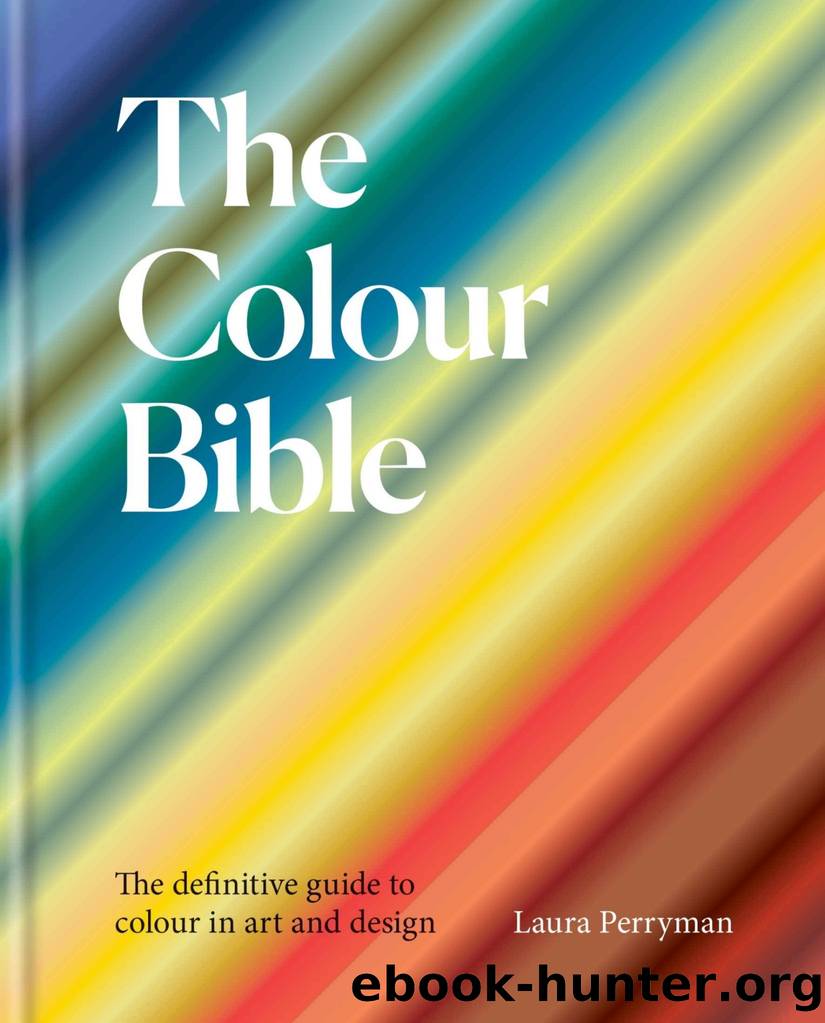The Colour Bible by Laura Perryman

Author:Laura Perryman [Perryman, Laura]
Language: eng
Format: epub
ISBN: 9781781578445
Publisher: Octopus
Published: 2021-09-02T04:00:00+00:00
Viktor & Rolf, Paris, Autumn/Winter 2019â20
Ultramarine
Colour Values
Hex code: #4166F5
RGB: 65, 102, 245
CMYK: 77, 63, 0, 0
HSL: 228, 73%, 96%
Common Connotations
⢠Divinity
⢠Distinction
⢠Perfection
Ultramarine in Art, Design & Culture
⢠The Dead Christ and the Virgin by Neapolitan follower of Giotto, painting, c.1330â40
⢠Hahn/Cock by Katharina Fritsch, sculpture, 2013
⢠Bluets by Maggie Nelson; cover design by Suzanne Dean, book, 2017
Then
Once worth more than gold, ultramarine is derived from lapis lazuli, a semi-precious stone mined in the mountains of Afghanistan and ground into a powder. The method for obtaining lapis lazuliâs intense colour â through purifying and kneading a combination of wax, resin and oil with the stoneâs naturally occurring mica and metallic amalgams â contributed to the pigmentâs price and its rarefied status.
Lapis lazuli first appeared as a pigment in the 6th century, used in Buddhist paintings in Bamiyan, Afghanistan. The Egyptian Book of the Dead recognizes lapis lazuli, carved in the shape of an eye and set in gold, as an amulet of inestimable power. Itâs no wonder that the colour was used to decorate the elite of ancient Egyptian society: Tutankhamunâs sarcophagus was ornamented with the stones; later, Cleopatra wore powdered lapis lazuli as eye shadow.
Ultramarine was also used in 13th- and 14th-century Anglo-Saxon illuminated manuscripts, where the key elements of the universe were pictorially illustrated with the pigment. These works showcase some early examples of colour association, with the brilliant ultramarine used to depict God the Creator; vermillion red standing for the earth or nature; and lead white representing the flesh.
Because of its prohibitive cost, Italian artists of the same period, such as Cimabue, Duccio and Giotto, preserved their stocks of ultramarine for important religious subjects, notably depictions of the Virgin Mary. A particular shade was even named after her: Marian blue. The colourâs alluring depth, radiant qualities and price led Baroque master Johannes Vermeer into monetary ruin. It remained expensive until a synthetic ultramarine was invented in 1826 by French chemist Jean-Baptiste Guimet, which was then aptly named âFrench ultramarineâ.
Now
Although the development of synthetic dyes and pigments have made a plethora of rich blues possible, ultramarine has retained much of its power. Twentiethcentury artists Wassily Kandinsky and Yves Klein both saw perfection and divinity in the rich colour, the latter using it as the base for his superlative IKB (International Klein Blue;). It remains a potent symbol of power as well: the Queen of the United Kingdom and the Chancellor of Germany often wear a royal blue sash at formal occasions.
Use
Play to the colourâs richness by combining it with sunkissed yellows and accents of violet-pink in a powerful triadic colour scheme.
The Virgin in Prayer by Giovanni Battista Salvi da Sassoferrato, 1640â50
Download
This site does not store any files on its server. We only index and link to content provided by other sites. Please contact the content providers to delete copyright contents if any and email us, we'll remove relevant links or contents immediately.
| Use of Color | Use of Ornament |
Wonder by R.J. Palacio(8518)
Mastering Adobe Animate 2023 - Third Edition by Joseph Labrecque(3817)
Unlabel: Selling You Without Selling Out by Marc Ecko(3628)
Ogilvy on Advertising by David Ogilvy(3557)
Hidden Persuasion: 33 psychological influence techniques in advertising by Marc Andrews & Matthijs van Leeuwen & Rick van Baaren(3522)
Drawing Cutting Edge Anatomy by Christopher Hart(3488)
The Pixar Touch by David A. Price(3392)
POP by Steven Heller(3327)
The Code Book by Simon Singh(3142)
Slugfest by Reed Tucker(2976)
The Art of War Visualized by Jessica Hagy(2975)
The Curated Closet by Anuschka Rees(2941)
Rapid Viz: A New Method for the Rapid Visualization of Ideas by Kurt Hanks & Larry Belliston(2875)
Stacked Decks by The Rotenberg Collection(2846)
365 Days of Wonder by R.J. Palacio(2790)
The Wardrobe Wakeup by Lois Joy Johnson(2756)
Keep Going by Austin Kleon(2732)
Tattoo Art by Doralba Picerno(2627)
Tell Me More by Kelly Corrigan(2624)
